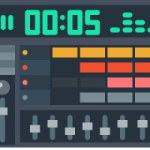目次
1.About Blackadder Chord
“Blackadder Chord” is a strange chord found in recent J-Pop and named by Joshua Taipale on YouTube in 2017.
The Video
He initially found the same chord in 7 songs below:
1. Guilty Eyes Fever
2. Labradrite
3. CANDY LOVE
4. Rhythm to Melody no tameno Ballad
5. WANDAFUL WORLD
6. Clover♧Kakumation
7. Ohayo, Mata Ashita
And now there’re many examples of this chord gathered in this spread sheet.
Chord Tones of Blackadder Chord
The Blackadder Chord (In this article I abbreviate it “Blk”) is explained as “A slashed chord composed of an augmented chord and the bass note +2 semitone higher than the root of upper aug.”
Super-dissonant sound! Really intriguing that such a monsterous chord lives peacefully in J-Pop world.
Seeing it as a stack from Root, its interval structure is :RtM2+4m7.
Now, before introducing this chord itself, I’d like to share some basic concept on chord theory.
2. Multiple Interpretations
There’re tons of examples reported, but the only thing common is the interval structure RtM2+4m7. That is, the context of this chord may vary.
Behind a structure lies a context. The meaning of a chord may differ according to its root and the parent scale. Let’s take Half Diminished Chord as an example.
They all are “Half Diminished Chords” but each one originates from different places. Starting from the left…
- the VIIth diatonic chord
- Related IIm of V/II
- ii borrowed from parallel minor key
- Borrowed from Lydian Scale
- Rootless form of V/V 9th, 1st inversion
It is these contexts that matters when you interpret chords or think of impressions they have. Scales or tensions you choose also varies according to these contexts. Since interval structure itself does not tell us these information, you cannot assert like “Half Diminished comes (solely) from ○○.”
The same thing is true of Blk chord. So one thing I strongly want you to remember is that Blk chord should not be seen as a single chord, but as a chord with many contexts & origins. Your analysis won’t end when you find Blk. It is where your analysis starts.
Blk’s Contexts
Among all chords, Blk especially has very large number of contexts. There’re 2 reason for this.
Being a Hybrid Chord
The first is that it’s a hybrid chord. Though Joshua primarily see it as a slashed chord, it can also be described as a tension chord (with 3rd omitted).
You cannot clearly say whether it’s (-5) or (+11) since the scale you play on a Blk chord may vary, anyway it’s a kind of Dominant Ninth Chord.
From both a slashed chord or a tension chord can a Blk arise. That’s the first reason why Blk chords have many contexts.
Being an Augmented Chord
The other is that, if you see it as a slashed chord, the upper triad is an Augmented Chord.
Aug chords are, like Dim7 chords, known for their characteristics that their chord quality doesn’t change when inverted.
And since a Blk has an independent bass note, there’s no way of knowing which note is the root of the upper triad, which makes interpretation a lot harder.
B♭aug/C has 2 other ways of describing it.
So just giving it a chord name can have 5 results (domi9(-5),domi9(+11), 3 aug patterns). And looking into it further, there’re multiple contexts behind them, according to their root degrees, parent scales, where they progress and what precedes them.
Hence the caution here again: Each Blk chord you encounter may have different origins.
3.Categorizing Blk Chord
This interpretation issue is so heavy that categorizing Blk chords must be the first thing to be done. I made a quick chart for that. (I’m gonna explain each category later on so you don’t need to read them thoroughly!)
As you can see, it’s super-complicated. What makes it so is that a Blk doesn’t have 3rd tone, which is crucial for a chord quality to be defined. So please note again that “many differently derived chords are all called Blackadder”.




